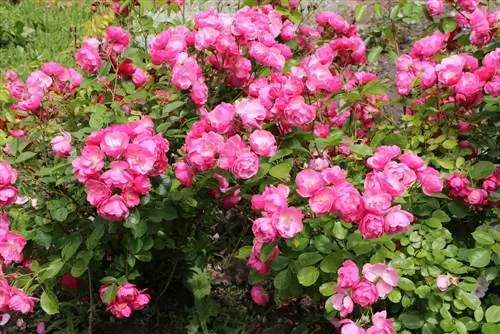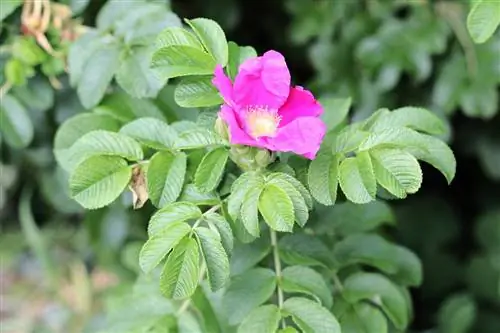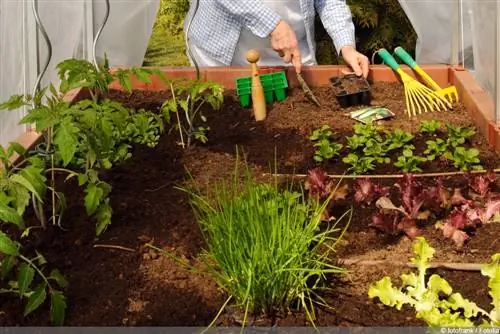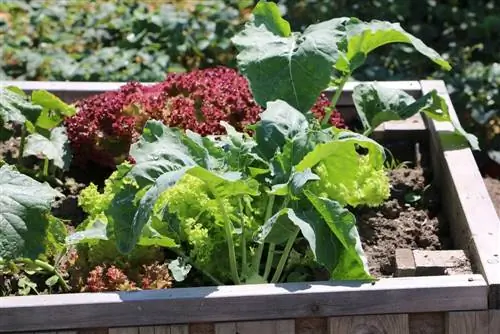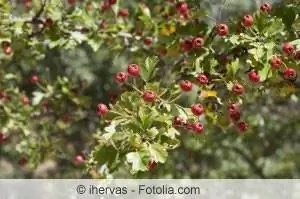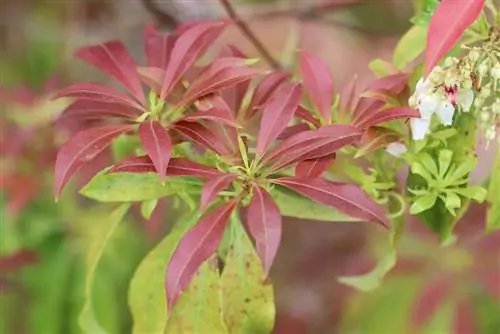- Author admin [email protected].
- Public 2023-12-17 03:39.
- Last modified 2025-01-24 12:45.
Pruning is the most important care for a bed rose. It's not hard to see - you basically shape the tree with pruning and also ensure the lush flowers through pruning. Pruning is of course important for the beauty of the bed roses. By cutting, you also ensure that the floribunda rose can feed itself well and grow airily and that fungi have no chance, so cutting is also fundamentally important for the he alth of the plant. There's just one thing the cut isn't: so complicated that you'd have to shy away from cutting, as the following instructions show:
Cuts and cutting purposes
- Small floribunda roses are formed into a pleasing growth habit through training pruning
- Before planting, young plants may need a pruning
- Both cuts are usually available for sale at the nursery
- For roses you have grown yourself, these pruning measures are your responsibility
- In the long run, floribunda roses only remain blooming if they are trimmed regularly
- The compact growth habit also gradually falls apart without cutting
- The basic cut is pretty straightforward:
- Take back all new side shoots to the desired extent
- Follow the guidelines of the parenting pattern
- Damaged wood continues to be removed (throughout the entire season)
- All of this also applies to standard roses, just a little attention when shaping the crown is needed
The upbringing cut
Let's assume you are dealing with a rose bush that you have been caring for since the seed developed into a seedling or a cutting developed roots and the first leaves/shoots.
Then it is your responsibility to train the young rose, depending on the planned shape:
- If the rose is to grow in a normal bush form, a framework of leading branches is formed
- Strong branches that are suitable in shape and position remain standing
- They are freed from competition as much as possible and necessary so that they can develop vigorously
- At the base all but the appropriate shoots are cut away
- From the branches that appear later, the shoots that continue the basic structure in the appropriate direction are allowed to continue to grow
- This means that all shoots that grow too close to the leading branches must first go
- They “steal” nutrients from the leading branches and would compact the stick inside
- Threes should be loosely structured inside because fungi love dense, moist plant mass
- In addition, shoots that grow unsteadily (crooked, twisted, etc.) or weakly are removed
- More needs to be done if the rose bush is to be grown into a (real) standard tree
- Then you first have to build a trunk with a crown
- The trunk is created by choosing a strong shoot as the trunk, from which any lateral growth is immediately removed
- Immediately is the key to success, every trunk shoot that is fed for a longer period of time causes the trunk to become a little thinner
- This method creates a standard tree whose height is tailored to the growth habit of the rose
Tip:
Through this upbringing you provide the basic shape and direction. While standard, normally shaped shrubs are grown in stores, here you have the option of creating a particularly wide-branched rose bush or a very narrow rose bush.
The plant cut
If you have purchased a young floribunda rose, the rose bush may need pruning before planting. This occurs when the ratio of root mass and plant mass in the upper area is not correct. If huge masses of roots are supposed to supply three leaves in the upper area, the unused nutrients lead to a kind of metabolic blockage; If large masses of plants grow on tiny roots, the plant cannot keep up with the supply.

The best training cut and the best correction of the “root-shoot ratio” (ratio of the roots to shoots and leaves) are achieved by the gardener with decades of experience. Because this is the case, the young plants in the mass trade have already undergone planting pruning and training pruning and can be planted as they are. You don't usually get roses growing on their own roots anyway, but rather cultivars grafted onto robust wild rose rootstocks. Which develop a special root-shoot ratio and are grown as a standard not according to plant specifications, but according to dealer specifications (which explains the half, quarter, three-quarter and everything else on offer).
If you buy bare-root roses that are not freshly harvested in the ground, a delicate plant cut is recommended, even if the main part has already been done by the dealer. It's just a matter of removing dried root ends so that the roots can absorb water and nutrients. If you buy from a specialist retailer, they will usually inform you exactly which cuts the rose needs now and in the future.
The basic cut
Once the rose has been planted and has taken root in your garden, it is “thoroughly pruned” once a year. This basic cut of a floribunda rose is not very complicated, the following points must be taken into account:
- The framework of supporting branches formed with the training cut provides the direction
- These guidelines will be followed
- All new side shoots are trimmed all around to the desired extent
- In addition, dead, slanting, rotten, broken wood is removed
- This can happen throughout the season
The best time for the basic cut
The best time to prune a floribunda rose depends on when and how often its flowers appear. Since the influences of all possible ancestors are noticeable in floribunda roses, there are a few variations in the flowering:
- There are floribunda roses that only bloom once a year - for a longer or shorter period of time
- These floribunda roses are pruned after flowering
- If the rose is to remain as it is, all fresh side shoots are cut down to a few eyes
- If the rose needs to grow in height, a few more eyes remain
- If the rose is already too tall, almost all of the new growth is cut away
- Here, old wood has to gradually give way so that new construction can take place from below
- This rejuvenation cut is made in the spring before budding
- Spread over 2 years depending on the constitution of the rose (heavy summer pruning weakens the plant)
- If a rose blooms continuously or multiple times, it gets its basic cut in spring
- In most German regions, the best time is the end of February/March
- In very cold regions, scissors are only used at the end of March/April
- Pruning takes place when the severe frosts are over and the roses are just about to start budding
- Weak and old shoots are removed completely, sick shoots also later in the season
- The more roses are cut back during the dormant period, the more sprouting is encouraged
- Carefully cut back strong-growing varieties at this time
- Motivate slow-growing varieties with vigorous pruning
- If a rose grows too densely inside, it will be thinned out during basic pruning
- The overall structure of the hive should be designed to be permeable to air on the inside
- If the stick has wood that hardly produces any flowers after two or three years, it needs to be rejuvenated
- To do this, the old shoots that are rotten before flowering are completely cut out of the cane, from the bottom up
- If wild shoots appear from the rootstock, they are treated as described below for standard roses
Tip:
If your floribunda rose blooms a lot and for a long time and you do not have the sales information about the flowering, you may want to know how the flowering of this cultivar is described in the specialist information. You can find out from the name of the cultivar on the Internet; The typical keywords have the following meaning: “Continuously blooming” means that a rose was grown to constantly produce new buds. “Frequently blooming” roses bloom in spurts and then take a break, “remontant” are bed roses with a strong main bloom and (small, isolated) secondary blooms (which can sometimes fail completely in non-optimal locations). By the way, floribunda roses should not always adhere to what is stated in the sales description.
Flower rose cutting in detail
" Single-flowering, continuous-flowering, frequent-flowering, remontant" affects the flowering and vigor of the rose bush and thus also the intensity of pruning.
If your floribunda rose, like a hybrid rose, only blooms once a year, there won't be much pruning to do in the first few years. Even later, such bed roses do not necessarily have to be trimmed every year. You will also have to cut these bed roses regularly to maintain their flowering potential. However, you can only target a few branches each year; every second to third season you should have caught every branch of the rose.
Multi-blooming and long-blooming floribunda roses that are cut back in spring need more vigorous pruning, every year. If you do not give them this pruning, the rose bushes will tend to fall apart and the flowering will diminish. Usually around two thirds of the total height is taken away with the cut. However, there are slower-growing bed roses for which this is not necessary, and in their obviously optimal locations there are almost overgrown bed roses that need to be cut back a little more and perhaps again in autumn.

For those that have bloomed once, you can use basic pruning to cut away the spent flowers. If there was a remontant among the ancestors, there may still be a regrowth. When it comes to multi-blooming flowers, cutting away the spent flowers is part of your program anyway if you want to see a lot of flowers: If you prevent roses from forming seeds (producing offspring) by cutting away the dead flowers, they will always develop a second bloom, if it is part of your genetic program and the time until winter still makes it possible.
Tip:
You can leave the last flower of a floribunda rose in the current season and let it ripen into rose hips. The fruits, which ripen from mid-September, should be harvested as soon as they reach maturity if they are to be further processed into puree and/or jam. If the rose hips are to be eaten raw, you should wait patiently until the first frost has passed over the plants. The frost causes the rose hips to become softer and sweeter, and in this state they can then be harvested until February. The fruit stalk remains on the plant as winter protection; its remains are removed when the rose receives its basic cut.
Cutting standard roses
The standard tree that you have grown yourself or that has been purchased fully formed is basically cut in the same way as described above. Just a little different in shape, of course, as the crown of the standard tree should usually grow more rounded.
Here you just have to make sure (even during the season) that you consistently remove all side shoots that appear below the grafting point or in the upper area of the usually grafted standard trees. If you remove a wild shoot too late, it may steal a few nutrients from the grafting plant. If you simply let a lot of wild shoots grow, it can happen that your very special breeding variety completely reverts to the wild form.
Wild shoots should not be cut off, this only encourages more wild growth. Rather, it would be better to demolish them, if possible down to the level of the grafting point in the ground.

